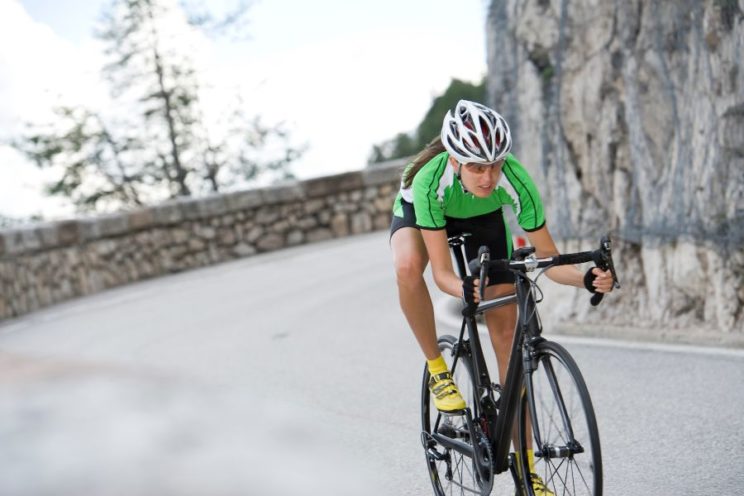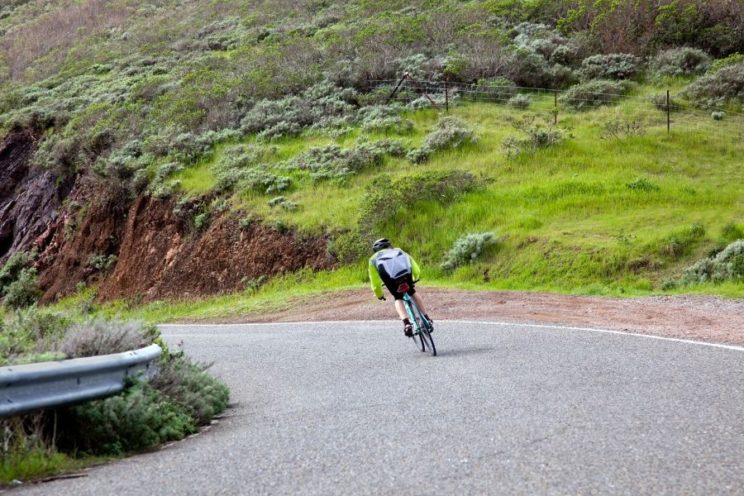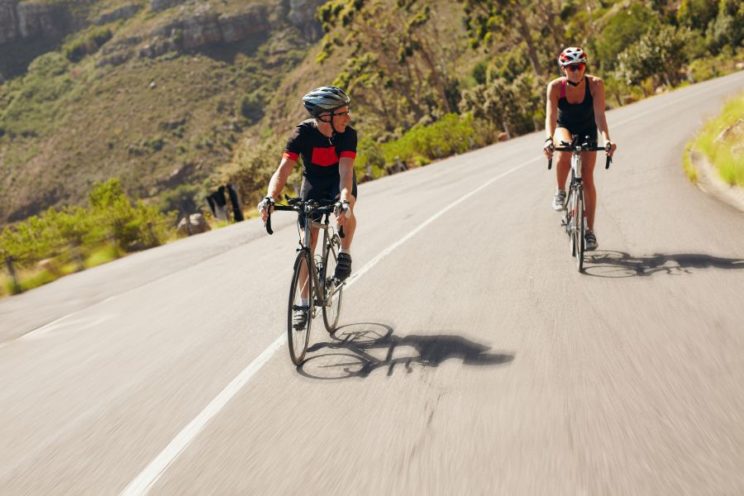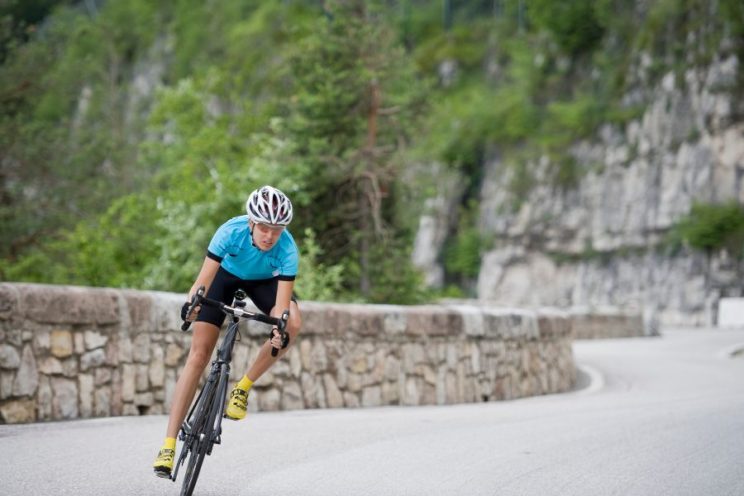Are you one of those cyclists who at least grab the brakes as if there were no morning? Does the memory of a fall overwhelm when you descend a port with an open grave? Are you unable to think about curves and speed without feeling a puncture in the stomach?
Do not suffer because you are not alone. For many cyclists, descending with dignity a port and staying in the group is a problem. And it is not something that happens only to rookie cyclists. Without going any further, there we have the example of
Remco Evenepoel, a portentous cyclist who usually shows weakness in the descents, surely motivated - in part - by that chilling fall in the Lombardy Tour of 2020.
Fear in the bike has an enormous power of attraction; The more we think about the danger, the more risk we run from having a mishap.
But many times our awkwardness or our fears on the bike are the result of
limiting beliefs They have little foundation. And it is known that fear has an undeniable power of attraction. The more we think of him, the more tickets we buy to get into trouble.
We will review some issues that will help you
download faster and more security. Especially, when the slope is accentuated and the road becomes reversed. They are the curves, precisely, the great
enemies of the fearful cyclist.
Concentrate on the road only
When you descend a port, you cannot think that you can suffer an accident. You should not visualize this circumstance in your mind. If you do,
You will block yourself and any descent will become an unpleasant experience.
There are formulas to avoid this circumstance. For example, draw curves trying to
imitate a grupeta partner That goes ahead and down safely. That concentration scares our fears; We simply abstract and, without realizing it, we go down faster.
Another limiting perception: when we descend with excessive precautions, without trust, we tend to disseminate the
Bike's ability To negotiate curves. In these cases, asphalt grip is greater than an inexperienced person usually demands.
However, we tend to block ourselves, we think that the bike will not endure and make wrong decisions. For that reason, we can end on the ground. Because of fear.
Descend relaxed It is key to increasing security.
Prepare to face the descents
[Captation Id = "Attachment_8265" Align = "Alignnone" Width = "744"]

Image: Gorfer (Getty images).[/caption]
The first thing you should do is make sure that
material From your bicycle it is adequate. Check that the tires maintain their drawing. It also attends to the pressures and width of tires.
In this sense, a somewhat lower front pressure that the rear can be a good idea, since it increases the traction of it. Remember that a block or skate of the rear wheel can be rectified; But if it occurs in front, the accident is almost certain.
Lower pressures and wider covers They contribute to increasing security. It is undeniable that the generalization of 25 mm, and even 28 mm, favors the management of less skilled people in declines.
One of the most addictive sensations is to lower ports drawing curves with confidence and enjoy the descent.
We do not aspire to become the beast of the descents. Simply, that you enjoy one of the best sensations that a road cyclist can experience: lower ports with joy and draw curves with confidence.
Watch your position on the bike
Focus on the position on the bike and in the
Distribution of your body weight About it. Tilt the bike in the curves, but do not turn the handlebar. It simply distributes the weight between the hand of the inside of the curve and the outer foot. Squeeze this with force down as if it were a counterweight. In this way, the bike will rotate, but your body will remain balanced.
[Captation Id = "Attachment_8283" Align = "Alignnone" Width = "744"]

Image: Gorfer (Getty images).[/caption]
If you see that the curve closes a little more than expected, applies more pressure with the hand on the same side of the handlebar to which the curve rotates. By pure inertia, the bike will enter the curve.
Is a
Practice question that you can train. Do you want to know how? Take a known slope and try to descend through it more and more speed. You will win in confidence. Almost without realizing it, you will make past faster, you will stop less and you will knock down the bike more.
To train the descents, take a known slope and try to descend through it more and more speed. You will win in confidence.
Descend with your hands in the lower part of the handlebar with the
Semi -Flexed arms and dolls, relaxed, as if it were an extension of your bicycle. With this position you get two things: you lower your center of gravity and distribute the weight of your body better, with special incidence in the front wheel, increasing the traction. It is the wheel that can get us most into trouble. Both issues influence stability and security.
[IRP Posts = "1926" Name = "What is the best posture to lower a port faster?"]
A position that can give you extra stability is
knee from the side to which the curve turns. To understand us, act as if you were a motorcyclist. Notice that many professional cyclists adopt this technique.
Master the technique of negotiating curves
Do not file the brave. At first, leave the speed until you acquire enough confidence. Focus first to draw gently taking advantage of the entire width of the road; Rather, your lane, if you whet by roads with open traffic.
[Captation Id = "Attachment_8275" Align = "Alignnone" Width = "744"]

Image: Igoraquaman.[/caption]
The way of acting must be the following:
-
To enter the curve: Open everything you can outward at controlled speed. Stop before entering, pressing both brakes. From there, they give them and let the bike slide naturally.
-
To get out of the curve: In the middle of it, attack it inside, drawing a kind of tangent line, and get out of the same opening again.
-
The focus of your gaze is fundamental. It is important that I always point towards the exit of the curve. Only with this gesture, your body will adopt a stable posture. You never look down or right in front of the bicycle. Nor do you recreate your attention on those objects or obstacles you want to avoid. Your bike will go where your gaze marks. It is the only way to anticipate.
-
Always brake in a straight line and avoid doing it in full curve, except in case of emergency and with extreme softness. Stilling sharply in a curve is the passport to an accident. If you see that the bike is thrown and you are forced to stop firmly, throw back the position of the rear. In this way, you will compensate for the inertia of the body to launch forward.
When you dominate this technique, you can increase speed.
Anticipate danger
Keep in mind that
anticipation It is one of the recipes to avoid possible problems. Let's say you must interpret each curve: provide for the presence of gravel or slippery elements (such as oil or animal droppings), examine the cant, intuit if it can be closed more than expected, attend to traffic signals, the road lines , to the removal, etc. Do not lose sight of, of course, vehicle traffic.
[Captation Id = "Attachment_8268" Align = "Alignnone" Width = "744"]

Image: Gorfer (Getty images).[/caption]
In any case,
Relax and focus on enjoying. If it is inevitable to suffer in the climbs, let's avoid doing so by going down. Don't you think?
If your body is tense, it is much more difficult to handle your bike. Keep in mind that you are
part of the suspension of your machine. Imagine your body as an extension of your bike's picture. You have to flow with her, accompany her in her reactions.
Look at the
professional cyclists. Do not imagine what you can learn contemplating how they negotiate the descents. Choose your favorite cyclist and try to imitate him at the next exit. But yes, much more slowly. It is also very useful, with we have previously pointed out, observe our grupeta partners with more skill in the descents.
 Image: Gorfer (Getty images).[/caption]
The first thing you should do is make sure that material From your bicycle it is adequate. Check that the tires maintain their drawing. It also attends to the pressures and width of tires.
In this sense, a somewhat lower front pressure that the rear can be a good idea, since it increases the traction of it. Remember that a block or skate of the rear wheel can be rectified; But if it occurs in front, the accident is almost certain.
Lower pressures and wider covers They contribute to increasing security. It is undeniable that the generalization of 25 mm, and even 28 mm, favors the management of less skilled people in declines.
Image: Gorfer (Getty images).[/caption]
The first thing you should do is make sure that material From your bicycle it is adequate. Check that the tires maintain their drawing. It also attends to the pressures and width of tires.
In this sense, a somewhat lower front pressure that the rear can be a good idea, since it increases the traction of it. Remember that a block or skate of the rear wheel can be rectified; But if it occurs in front, the accident is almost certain.
Lower pressures and wider covers They contribute to increasing security. It is undeniable that the generalization of 25 mm, and even 28 mm, favors the management of less skilled people in declines.
 Image: Gorfer (Getty images).[/caption]
If you see that the curve closes a little more than expected, applies more pressure with the hand on the same side of the handlebar to which the curve rotates. By pure inertia, the bike will enter the curve.
Is a Practice question that you can train. Do you want to know how? Take a known slope and try to descend through it more and more speed. You will win in confidence. Almost without realizing it, you will make past faster, you will stop less and you will knock down the bike more.
Image: Gorfer (Getty images).[/caption]
If you see that the curve closes a little more than expected, applies more pressure with the hand on the same side of the handlebar to which the curve rotates. By pure inertia, the bike will enter the curve.
Is a Practice question that you can train. Do you want to know how? Take a known slope and try to descend through it more and more speed. You will win in confidence. Almost without realizing it, you will make past faster, you will stop less and you will knock down the bike more.
 Image: Igoraquaman.[/caption]
The way of acting must be the following:
Image: Igoraquaman.[/caption]
The way of acting must be the following:
 Image: Gorfer (Getty images).[/caption]
In any case, Relax and focus on enjoying. If it is inevitable to suffer in the climbs, let's avoid doing so by going down. Don't you think?
If your body is tense, it is much more difficult to handle your bike. Keep in mind that you are part of the suspension of your machine. Imagine your body as an extension of your bike's picture. You have to flow with her, accompany her in her reactions.
Look at the professional cyclists. Do not imagine what you can learn contemplating how they negotiate the descents. Choose your favorite cyclist and try to imitate him at the next exit. But yes, much more slowly. It is also very useful, with we have previously pointed out, observe our grupeta partners with more skill in the descents.
Image: Gorfer (Getty images).[/caption]
In any case, Relax and focus on enjoying. If it is inevitable to suffer in the climbs, let's avoid doing so by going down. Don't you think?
If your body is tense, it is much more difficult to handle your bike. Keep in mind that you are part of the suspension of your machine. Imagine your body as an extension of your bike's picture. You have to flow with her, accompany her in her reactions.
Look at the professional cyclists. Do not imagine what you can learn contemplating how they negotiate the descents. Choose your favorite cyclist and try to imitate him at the next exit. But yes, much more slowly. It is also very useful, with we have previously pointed out, observe our grupeta partners with more skill in the descents.












